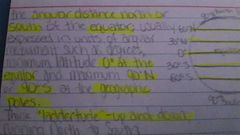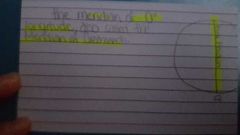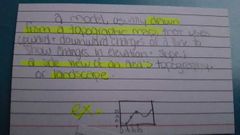![]()
![]()
![]()
Use LEFT and RIGHT arrow keys to navigate between flashcards;
Use UP and DOWN arrow keys to flip the card;
H to show hint;
A reads text to speech;
97 Cards in this Set
- Front
- Back
|
classification |
the grouping together of similar observations and inferences to make the study of objects in the environment easier to understand or more meaningful |
|
|
cyclic change |
an orderly change in the environment in which an event repeats itself with reference to time and space, the opposite of random change |
|
|
density |
the concentration of matter in an object; the ratio of mass to volume- the mass per each unit of volume. D= M÷V how much mass is in a given volume (crowdedness) ^ /M\ / D V \ ---------- |
|
|
Inference |
an interpretation of an observation; a mental process that proposes causes, conclusions, or explanations for what has been observed. |
|
|
instrument |
a device invented by people to extend the senses beyond their normal limits, thus enabling them to make observations that would otherwise be impossible or highly innacurate. |
|
|
mass |
the amount of matter (stuff) in an object, not affected by location *doesn't change!* |
|
|
measurment |
a means of expressing an observation with greater accuracy or precision; provides a numerical value for an aspect of an object or event being observed by comparison with a standard ex. measuring the length of paper with a ruler |
|
|
natural hazard |
a non-human related object, process, or situation that had the possibility of causing loss of life, personal injury, or loss of property. includes... volcanic eruptions, earthquakes, landslides, floods, storms, and asteroid impacts. also called a natural disaster. |
|
|
observations |
the perception of some aspect of the environment by one or more human senses, with or without the aid of instruments. |
|
|
percent deviation |
(or percent error ) the numerical amount expressed as a percent by which a measurement differs from a given standard or accepted value. formula: difference from accepted value --------------------------------------------- ×100 accepted value |
|
|
prediction |
a type of inference about the conditions and behaviors of the environment in the future |
|
|
rate of change |
how much a measurable aspect of the environment (called a field) is altered over a given time- years, hours, or seconds rate of change= change in field value -------------------------------- change in time |
|
|
volume |
the amount of space an object takes up. V= l×w×h or, for irregular objects, use water displacement method. |
|
|
contour lines |
an isoline (A line used to connect points of equal value) on a topographic, or contour, map that connects points of equal elevation on the surface of any solid celestial body, such as earth. |
|
|
coordinate system |
a grid or system of lines for determining location of a point on a surface, such as latitude and longitude of a point on earth. |
|
|
elevation |
the vertical distance or height above or below sea level. |
|
|
equator |
the parallel on earth midway between the geographic north and south poles with a latitude of 0° |
|
|
field |
any part of the universe that has some measurable value of a given quantity at every point, such as earths magnetic field and the sun's gravitational field |
|
|
gradient |
the rate of change from place to place within a field, also called slope. gradient= amount of change in field --------------------------------------- distance through which change occurs or change in field value --------------------------------- distance |
|
|
isoline |
a line used on a model of a field, such as a map, to connect points of equal value of a field quantity ex. isotherms, isobars, and contour lines |
|
|
latitude |

|
|
|
longitude |

|
|
|
meridian of longitude |
any north-south semicircle of constant longitude on maps and globes connecting the north and south poles- also called a meridian. |
|
|
model |
any way of representing the properties of an object, event, or system, includes graphs, drawings, charts, mental pictures, numerical data, or scaled physical objects. |
|
|
prime meridian |

get picture |
|
|
profile |

get picture |
|
|
topographic map |
a model of the elevation field of a solid celestial object, such as earth, using contour lines and other symbols, also called a contour map. |
|
|
measurements have... |
quantity and a UNIT!! |
|
|
the imperial/ British system |
is inches, feet, miles, etc |
|
|
the metric system |
Based on 10; centimeters, meters. easy to convert |
|
|
converting in metric- acronym |
King Henry Died U Didn't Care Much K H D U D C M Kilo, Hecto, Deca, (units), Deci, Centi, Milli |
|
|
mass |
How much matter (stuff) is in an object - doesn't change |
|
|
weight |
Measure of gravitational force acting on an object (changes If gravity changes example: going to the Moon) |
|
|
How are mass and weight different? |
Mass never changes, but weight can |
|
|
triple beam balance |
Find mass (remains constant) |
|
|
Ruler |
Measures length / width / height |
|
|
spring scale |
Finds weight (change due to gravity) |
|
|
thermometer |
Measures how hot something is (measuring Heat by molecular movement) |
|
|
How many degrees Celsius is the freezing point of water |
0 °C |
|
|
How many degrees Celsius is the boiling point of water |
100 °C |
|
|
what is volume |
How much space an object takes up |
|
|
How do you measure volume of a regular object |
Since the length, width,and height are all constant (like in a block, but not necessarily the same as each other) you can measure volume with a ruler: length x width x height = volume (in centimeters cubed) |
|
|
How do you measure the volume of an irregular object |
Since the length, width, and height are not constant, you can't use a ruler. Use the water displacement method. |
|
|
What are the steps of the water displacement method |
1 fill container with water 2 record volume of water 3 place in the object 4 record new volume 5 the amount that the water went up is the volume of the object. |
|
|
1 cm cubed equals? |
1 milliliter, since it would take 1 ml of liquid to fill a 1 cm cubed box |
|
|
What is density |
Density is how much mass is packed into a given volume. density is weight compared to volume. |
|
|
What equation can you use to find density |
Mass ÷ volume |
|
|
How can you find the mass of an object when given the density and the volume |
Multiply the density by the volume |
|
|
How can you find the volume of an object when given the mass and the density |
Mass ÷ density |
|
|
What is the density of water |
1.0 g/cm3 or 1g/ml (since cm3 and 1 ml are the same) |
|
|
Does density change with size |
NO! cutting an object in half or making it larger does not change its density!! when you reduce the volume you are also reducing the mass by the same percent. Density is the crowdedness inside of the object! |
|
|
What can change density? |
1. Adding or removing Mass but not volume. ( like how the Titanic took on water (mass) so it sank.) 2. Changing the volume but not mass adding or removing temperature changes volume (like hot air balloons rise because the gas expands) |
|
|
What happens to the object's density if you heat it? |
The density will go down. (drop it like it's hot) |
|
|
Does density mean weight or size? |
No!! A light object can be very small and Compact and have a high density (like a rock) a heavy object can be large and spread out and have a low density (like a cruise ship) |
|
|
What is percent error deviation |
How far off you are from the correct answer |
|
|
What is the formula for percent error deviation |
l accepted value- your answer l % error = ------------------------------------- accepted value |
|
|
What is a line of best fit |
The line of best fit is an average of your plots |
|
|
What are sunspots |
Spots on the Sun that look darker after a solar flare erupts since the area underneath is left cooler. |
|
|
What is the actual shape of the Earth |
An oblate spheroid |
|
|
Why is the earth an oblate spheroid, and what is an oblate spheroid? |
an oblate spheroid appears to be a sphere but it slightly shorter top to bottom and bulging at the sides. This is because of our Earth's rotation. |
|
|
What is latitude and longitude |
A coordinate system to find locations on Earth |
|
|
What is latitude |
The measure of distance north and south of the Equator
(laddertude; ladders go up and down) |
|
|
Where is the equator located |
0° latitude |
|
|
What is the latitude range |
0° to 90° north or south |
|
|
What is longitude |
The measure of distance east and west of the Prime Meridian |
|
|
What is the prime meridian |
0° longitude, runs through Greenwich, England |
|
|
What is the longitude range |
0° to 180° east or west (can only go halfway around a circle) |
|
|
What is a meridian |
A line of equal longitude runs between North and South Pole, that measure east and west |
|
|
What is a parallel |
Lines of the same latitude running east and west on the map but measuring North and South. |
|
|
What is special about the star Polaris |
Polaris's altitude is your latitude. This means that whatever angle Polaris is in the sky, that's your latitude. At the North Pole, Polaris is at 90 degrees. At the equator it's at 0 degrees. |
|
|
What is the International Date Line |
The International Date Line is there to stop us from going too far back or forward in time. It resets the day. |
|
|
What happens if you cross the International Date Line West? What about if you cross it East? |
If you're Crossing West, you add one day. if you're Crossing East, you subtract one day. |
|
|
What is a time zone |
A longitudinal belt in which all areas have the same local time. |
|
|
Why do we have time zones |
Since Earth rotates not every place gets done at the same time. To fix this different places are set to different times. |
|
|
Which way does the sun move, and which way do time zones move as well? |
East to west. This is because the Earth rotates counterclockwise. |
|
|
What is Earth's rate of rotation |
15 degrees per hour (360 degrees in 24 hours) |
|
|
How far apart are time zones |
They are all 15 degrees apart (Earth's rotation) |
|
|
What is a topographic map |
Shows different elevations using contour lines ( AKA contour maps ) |
|
|
What is a contour line |
A line of equal elevation. If you walk along a contour line, your elevation will not change. |
|
|
contour maps: the closer together the lines are the ________ the slope |
steeper |
|
|
The further apart the lines, the _______ the slope |
gentler |
|
|
Can contour lines ever cross |
NO! since they are all different elevations, they will never cross |
|
|
What is a profile |
A profile is a side view of a contour map. |
|
|
gravity |
An attractive force that exists between any two particles in the universe |
|
|
What Falls faster a heavy object or a light object |
Objects fall at the same rate because a more massive object has more gravity pulling down on it, so the force to move is still equal. |
|
|
Do all objects fall at the same rate on Earth |
No, not all objects fall at the same rate due to air resistance (which is an outside force) that counteracts gravity |
|
|
Does the weight of an object affect the falling rate |
No |
|
|
What things can affect how fast an object falls through the air |
Shape and surface area. |
|
|
Would objects fall at the same rate if there was no air resistance |
Yes they do fall at the same rate. (like on the moon, which is a vacuum, a feather and a hammer fell at the exact same time) |
|
|
What is an isotherm |
Lines of the same Heat |
|
|
What is an isobar |
Lines of equal pressure (barometric pressure) |
|
|
What is a quantitative observation |
Uses numbers (quantity) example: 12 inches This is more scientific. |
|
|
What is a qualitative observation |
Uses descriptions (quality) example: large box |
|
|
what is an inference |
An educated guess based on an observation |
|
|
What is a heat source |
Something that makes or creates Heat |
|
|
What is a heat sink |
Where heat leaves an area like a door or a window. |
|
|
What is heat |
A measure of molecular movement in an object |

